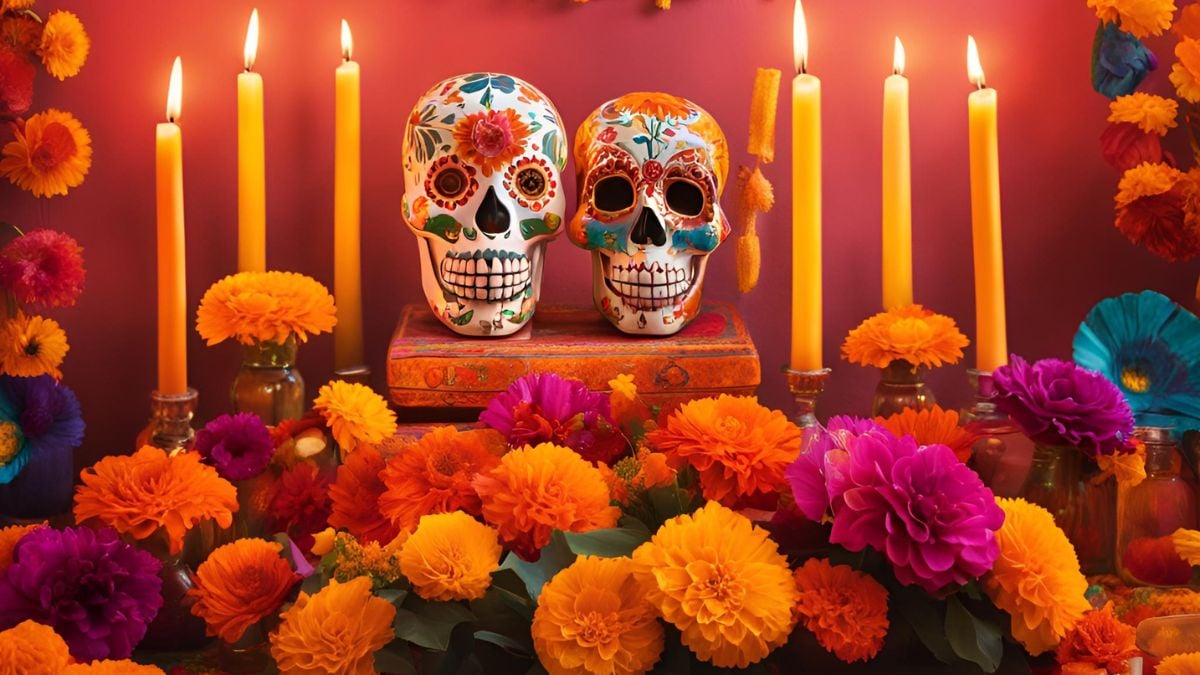
Each year in Mexico, November 1st and 2nd mark an extraordinary celebration: Día de los Muertos, or Day of the Dead. In a country where death is traditionally feared or mourned, Mexicans have created a colorful, deeply symbolic fiesta that honors loved ones who have passed away. It’s a time when families come together to celebrate and remember, transforming grief into festivity and creating a bridge between life and death.
Why Do Mexicans Celebrate Death?
Unlike many cultures where death is met with solemnity and sorrow, Mexico embraces it with joy and reverence. For Mexicans, Día de los Muertos is a “fiesta” or celebration, a time when families reconnect with those who have departed. Every November, Mexicans honor the dead with altars and offerings known as ofrendas, which are carefully prepared with symbolic elements to welcome back the spirits of loved ones.
This celebration may be hard to understand for some; in many places, death is associated strictly with loss, pain, and grief. However, Día de los Muertos invites people to approach death differently: as a reminder of the love and memories shared, and as an opportunity to celebrate life itself.
ALSO READ. When does Walmart Halifax open? The store where an employee was found dead in an oven
What is the Purpose of the Altar de Muertos?
The Altar de Muertos is a beautiful and intricate ritual central to Día de los Muertos. It is not only a place to honor loved ones but a medium through which the living and dead reconnect. Every element in the altar is symbolic, bringing together traditional items that allow families to conjure the presence of their deceased loved ones.
Some of the essential elements of an altar include:
- Marigold flowers (Cempasúchil): Their vibrant color and fragrance are believed to guide the spirits back home.
- Candles: Light to guide the spirits’ path to the altar.
- Pan de Muerto (Bread of the Dead): A traditional bread meant to nourish the spirits.
- Sugar Skulls: These represent the deceased, often decorated with their names.
- Favorite items or foods: Personal items that remind the spirits of the pleasures of life.
Through these altars, Mexicans not only remember the deceased but also recreate a space where both worlds—the living and the dead—come together. It’s a tradition that reflects a unique perspective on death, emphasizing remembrance, love, and celebration.
Why is There a Rise in Google Searches About Día de los Muertos?
Recently, there has been a significant increase in Google searches related to Día de los Muertos, especially queries like, “Do you say Happy Día de los Muertos?” This question is genuine, as it may seem strange to combine words like “happy” and “death” in one phrase.
But Mexico has found a way to do it—and they do it grandly. The idea of wishing someone a “Happy Day of the Dead” may sound contradictory at first, but the phrase reflects the essence of Día de los Muertos: it’s not about mourning; it’s about honoring life, love, and the memories of those who have passed. Thanks to the international success of Disney Pixar’s Coco, a film that beautifully captures the essence of this tradition, Día de los Muertos has gained global recognition, and with it, a growing interest in understanding and participating in its customs.
Can You Really Say “Happy Día de los Muertos”?
So, can you really wish someone a “Happy Día de los Muertos?” The answer is yes. Día de los Muertos is about joyfully remembering those we have lost. It’s a celebration of life’s impermanence and an opportunity to connect with loved ones on a spiritual level. The tradition reminds us to embrace the memories, laugh, cry, and ultimately, find happiness in the time shared together.
Thus, if you’re wondering whether it’s appropriate to say “Happy Día de los Muertos,” the answer is absolutely yes. Mexicans celebrate death with reverence and joy, transforming a somber concept into a monumental celebration that honors those who have gone but continue to live on in our hearts and minds.
How Many Levels Are in a Day of the Dead Altar?
The number of levels on an altar varies, with the most common being two, three, or seven levels. Each represents something unique:
- Two-Level Altar: Symbolizes the duality of the world—Heaven and Earth.
- Three-Level Altar: Represents Heaven, Earth, and the Underworld (Mictlán).
- Seven-Level Altar: This is the most complex and represents the seven steps the soul must travel to reach eternal rest.
In a three-level altar:
- First Level (Heaven): Represents the celestial plane, where spirits and gods reside.
- Second Level (Earth): Represents the earthly realm where the living reside and where the departed temporarily return.
- Third Level (Underworld): Symbolizes Mictlán, the resting place of souls.
Key Elements of the Altar and Their Meanings
- Marigold Flowers (Cempasúchil): Known as the “flower with twenty petals,” its bright yellow or orange color represents the sun. The strong aroma guides the souls from the afterlife to the altar. Often used in paths leading from the home entrance to the altar to ensure the spirits don’t lose their way.
- Candles and Candleholders: Light the way for souls, guiding them back to the living world. Each candle represents a soul, and traditionally, they are placed in four cardinal directions for navigation.
- Arch (Arco): The arch represents the gateway between the living and the dead. It serves as the portal through which the spirits pass to reach the altar and receive the offerings. Often decorated with marigolds and cut paper (papel picado), it symbolizes the transition from the earthly to the spiritual plane.
- Bread of the Dead (Pan de Muerto): This round bread represents the cycle of life and death. Its bone-shaped decorations honor the deceased and symbolize unity between the living and the dead.
- Colored Candles:
- White: Purity and hope, often used for children’s souls.
- Yellow: Represents the sun and is used for adult souls.
- Purple: Symbolizes mourning and is used in prayer for souls still searching for peace.
- Mirror: Some altars include a mirror for visitors to see themselves, symbolizing the duality of life and death. The dead view their absence, while the living reflect on their mortality.
- Salt: Often placed in small containers on the altar, salt purifies the spirit, allowing it to arrive “cleansed” in the living world. It also protects against negative spirits that may interfere.
- Glass of Water: Represents life and purity, offering refreshment to the spirits after their long journey. It also symbolizes the hope that the souls find peace.
- Image of Souls in Purgatory: Sometimes an image of the Souls in Purgatory is placed on the altar to help free the souls of those who may be stuck there, assisting them on their spiritual journey.
- Saint Images: Placing saint images on the altar helps intercede between the living and the deceased, symbolizing the ongoing spiritual connection between families and their loved ones.
- Xoloitzcuintli Dog Figurines: This ancient breed of dog, believed to accompany souls on their journey, is especially placed on children’s altars to provide company and help guide them through the final passage to Mictlán.
- Cut Paper (Papel Picado): Represents the wind and the fragility of life, as the delicate paper can tear easily. Decorated with colorful patterns of skeletons and skulls, it brings a festive, welcoming touch to the altar and celebrates the return of the spirits.
- Petate Mat or Cloth: Used as a bed or tablecloth, it provides a place for the spirits to rest and a surface for the food offerings.
- Soap, Water, and Towel: These are offered to allow the souls to cleanse themselves after their long journey.
- Cross: If made of salt, it symbolizes purification. If made of ash, it helps the spirit expiate any remaining burdens.
- Alfeñique Sweets: These sugar figures come in shapes like animals, baskets, flowers, shoes, souls, and coffins, adding color and sweetness to the altar as a cheerful offering.










